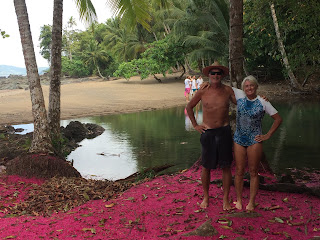From
Mexico all the way to Nicaragua, trash of every kind is seen in depressing
profusion all over the roads, countryside, rivers and beaches. Then you arrive
in Costa Rica, where trash is barely to be seen. To be sure, less poverty
probably plays a big role in this difference, but this observation does not
give adequate credit to their differences in attitude. Costa Rica has for
several decades focused heavily on development of their tourist industry and
this has lifted their economy. Yet they seem to have understood far earlier and
better than their neighbors that strewn trash would be poison to not just their
tourism, but also to their land.
Rightly
famed for its verdant forest jungles and exotic animal sight-seeing, the cycle
has proven to be a virtuous one for Costa Rica. Tourists, European ones
especially, noticed and praised Costa Rica for its many protected parks and its
clean streets. The government responded with additional parkland declarations
and a garbage collection and recycling system that is far superior to any of
their Central American neighbors.
The
result for tourists is access to untrammeled beauty. In the dense jungles and
seas of Costa Rica there are creatures galore. Plants, fishes, birds, insects
and animals are everywhere to be seen and the existence of all this life
provides a beacon of hope that the declining health of our planet is not a
forgone conclusion.
This
was our second tour of Pacific Costa Rica, having last year sailed south as far
as Bahia Drake (pronounced “Drack-eh” in these parts). This year we again stopped at this lovely place on earth before carrying onwards to Golfito, in southern
Costa Rica.
Traveling
southbound through Central America it should not be a surprise to learn that
there are fewer and fewer sailors willing to range so far from home. Unlike the
busy anchorages of the Pacific Northwest, there are more often than not no other
cruising boats at all.
Our
outermost destination this season will be the western islands of Panama, where
we have now arrived. Our sailing companions on Avant are this season bound
for the Panama canal and we, late in the season, for southern Mexico. So in
about two weeks time we will have to bid our friends good passage and head in
opposite directions. But for now we continue to enjoy each other’s company and
the support that comes from knowing if problems develop on the boat there is
someone to lend a hand.
And now for the photos....
And now for the photos....
Avant and Anduril crew awake early to dingy ashore and explore the Curu Wildlife Refuge. We spotted deer, falcons, white faced capuchins, spider monkeys, coatis, and parakeets.
Lunch with Henry and Pamela at the Hook Up Bar at Herradura.
Punta Quepos offered a beautiful swimming beach with a resident sloth; a restaurant with pool was a short walk up the hill.
Anchored off Manuel Antonio National Park we swam and kayaked ashore (kayak to be temporarily confiscated by Park Rangers) to explore. Sloths, white faced capuchins, howler monkeys, toucans, coatis, iguanas, agoutis, and spider monkeys were all to be seen.
Next, we anchored at Bahia Drake and enjoyed the jungle river dingy trip, Restaurante Amapola, a diving and a snorkeling trip to Isla del Cano. Avant went on a guided excursion to Corcovado Park.
Our last stop in Costa Rica was Golfito. We stocked up on groceries and duty free alcohol. We experienced the intensity of our first heavy ITCZ rain storm.
One of many confiscated semi submersible submarines used for drug smuggling.

































No comments:
Post a Comment